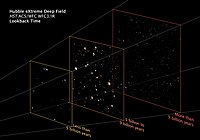The History of BIG BANG Theory
Etymology
English astronomer Fred Hoyle is credited with coining the term "Big Bang" during a 1949 BBC radio broadcast, saying: "These theories were based on the hypothesis that all the matter in the universe was created in one big bang at a particular time in the remote past."
It is popularly reported that Hoyle, who favored an alternative "steady state" cosmological model, intended this to be pejorative,but Hoyle explicitly denied this and said it was just a striking image meant to highlight the difference between the two models.:
Development
Hubble eXtreme Deep Field (XDF)
XDF size compared to the size of the Moon – several thousand galaxies, each consisting of billions of stars, are in this small view.
XDF (2012) view – each light speck is a galaxy – some of these are as old as 13.2 billion years– the universe is estimated to contain 200 billion galaxies.
XDF image shows fully mature galaxies in the foreground plane – nearly mature galaxies from 5 to 9 billion years ago – protogalaxies, blazing with young stars, beyond 9 billion years.
The Big Bang theory developed from observations of the structure of the universe and from theoretical considerations. In 1912 Vesto Slipher measured the first Doppler shift of a "spiral nebula" (spiral nebula is the obsolete term for spiral galaxies), and soon discovered that almost all such nebulae were receding from Earth. He did not grasp the cosmological implications of this fact, and indeed at the time it was highly controversial whether or not these nebulae were "island universes" outside our Milky Way.Ten years later, Alexander Friedmann, a Russian cosmologist and mathematician, derived the Friedmann equations from Albert Einstein's equations of general relativity, showing that the universe might be expanding in contrast to the static universe model advocated by Einstein at that time.In 1924 Edwin Hubble's measurement of the great distance to the nearest spiral nebulae showed that these systems were indeed other galaxies. Independently deriving Friedmann's equations in 1927, Georges Lemaître, a Belgian physicist, proposed that the inferred recession of the nebulae was due to the expansion of the universe.
In 1931 Lemaître went further and suggested that the evident expansion of the universe, if projected back in time, meant that the further in the past the smaller the universe was, until at some finite time in the past all the mass of the universe was concentrated into a single point, a "primeval atom" where and when the fabric of time and space came into existences
Starting in 1924, Hubble painstakingly developed a series of distance indicators, the forerunner of the cosmic distance ladder, using the 100-inch (2.5 m) Hooker telescope at Mount Wilson Observatory. This allowed him to estimate distances to galaxies whose redshifts had already been measured, mostly by Slipher. In 1929 Hubble discovered a correlation between distance and recession velocity—now known as Hubble's law.[18][51] Lemaître had already shown that this was expected, given the cosmological principle.
In the 1920s and 1930s almost every major cosmologist preferred an eternal steady state universe, and several complained that the beginning of time implied by the Big Bang imported religious concepts into physics; this objection was later repeated by supporters of the steady state theory.This perception was enhanced by the fact that the originator of the Big Bang theory, Georges Lemaître, was a Roman Catholic priest.Arthur Eddington agreed with Aristotle that the universe did not have a beginning in time, viz., that matter is eternal. A beginning in time was "repugnant" to him.Lemaître, however, thought that







Comments
Post a Comment